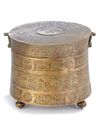A BRONZE LIDDED DAWAT, 12TH-13TH CENTURY, CENTRAL ASIA
A large golden brass coloured bronze pot with fitted air-tight lid that suggests a utilitarian purpose – perhaps originally to hold medicines, spices and incense, which would need to be protected from the outside conditions, as well as kept secure.
The pot with three lines of delicately inlaid epigraphic Kufic panels which run around most of the body.
Another line of inscription runs around the rim of the lid, where the remains of a hinge can be seen on one side.
18 cm.height, 24 cm. diam.
CATALOGUE NOTE
The intricate decoration highlights the Islamic fascination with calligraphic script, which was elevated from a means to transmit text to an exalted art form where the shape, style, size and colour of the lettering became its own exquisite form of decorative motif. It also highlights the pursuit of the written word at the time, with a thirst for academia, poetry and religious inscriptions being pursued.
Often vessels of this type are topped with a domed lid, in resemblance to a domed building or minaret - it is rare that an example of this type has a simple flat top. This vessel is similar in style but much larger in size to the dawat inkwells found throughout the medieval Islamic world.
Metalworkers frequently used bronze as the main body for practical objects, however the technique of inlaying with gold, silver, black niello and copper wire was widely popular as a form of decoration. Incisions were made, into which copper wire was hammered, creating a beautiful contrast of the green gold bronze and the red of the copper wire that obtains a beautiful rich patina over time. Such objects convey the wealth of the owner as a conspicuous display, but also tell of their taste and refinement, and Islamic metalwork such as this is one of the greatest surviving remnants of the period, which remains highly prized today.
No two of these large cylindrical boxes are alike, suggesting that each would have been most likely custom made to the patron’s wishes.
A similar style large cylindrical in the Metropolitan Museum of Art in New York and the Khalili Collection in London.





